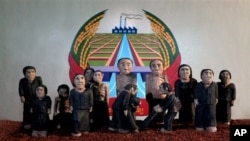WASHINGTON DC —
Cambodia recently got a boost when one of its movies was nominated for the 2014 Academy Award for the Best Foreign Language Film. The Missing Picture is the first Cambodian film to be nominated for an Oscar. Set during the Khmer Rouge rule of the 1970’s, it uses clay figures to tell the story of a family and a nation gripped by genocide.
“Personally, I’m very happy for me and my team, but now, if I watch what people write on social networks, people are very proud, it’s the first time for us,” said director Rithy Panh, speaking from Phnom Penh. “It’s not only about me now, it’s about our country.”
Panh based the film on his autobiographical book The Elimination, and it recreates the suffering he, his family and the nation went through during the period.
In 1975, when Panh was 11, the Khmer Rouge forced his family to leave the Cambodian capital and relocate to a rural “rehabilitation camp.” His father was an educator, and the family was considered members of the middle class that the regime wanted to eliminate.
Panh’s parents, siblings, a niece and nephew, and most of his childhood friends were among the 1.8 million people who died during the Khmer Rouge’s reign. Victims were executed, or died of disease, starvation, or overwork.
Panh fled to neighboring Thailand in 1979, and eventually moved to France, where he studied film. He now divides his time between Paris and Cambodia, and has established an award-winning career as a director and screenwriter, specializing in films about the Khmer Rouge period.
In this latest film, Panh uses clay figures to substitute for pictures or film of the Khmer Rouge era that can’t be found. He met with former members of the movement who told him that they did film and photograph their actions, but the documentation is now missing.
“It’s a genocide without images,” said Panh.
The filmmaker tried to construct a model of his childhood home, and he asked an assistant to produce a small figure of young boy using clay.
“When we were young, we went to the river, and we got some clay, and we produced animal figurines, and we tried to tell a story with that,” he said.
As the assistant worked, Panh decided to use the clay figures to tell his story.
“When we pray to Buddha, we are not praying to a piece of stone, an image of Buddha, but we pray to the soul of Buddha behind the piece of stone,” he said. “The souls of the people who are dead now are still with us.”
Panh hopes his films will help young Cambodians to understand their country’s history.
“People of my generation did not like very much to tell what we lived through during the Khmer Rouge regime,” he says. “It’s not easy to explain to the new generation, the young people why we cannot protect our families, why we can’t help them to survive.”
Panh believes the era’s survivors continue to grapple with guilt.
“In fact, we are guilty of nothing,” he said. “You did not survive because you were stronger or cleverer than other people; you are still alive because people helped you to be here today.”
The Missing Picture’s nomination occurs as the country confronts new turmoil, as opposition activists clash with government forces. The opposition Cambodia National Rescue Party has conducted protests, saying voting fraud took place during elections last July. The government of Prime Minister Hun Sen has rejected the accusations, and refuses to organize new polling.
“You know at this moment we have to face many problems, and then you have good news like this, and everybody is happy,” Panh said about the film’s nomination.
Many of those that lived through Cambodia’s Khmer Rouge era continue to struggle to rebuild their lives.
“We survivors of the genocide, it is like we are dead already, but we are reborn again,” Panh said. “We learn to love; we learn to appreciate the taste of food, the smell of flowers, and every day for us we learn to live, because a life is a very precious thing that you have now.”
The Academy Award winners will be announced on March 2.
“Personally, I’m very happy for me and my team, but now, if I watch what people write on social networks, people are very proud, it’s the first time for us,” said director Rithy Panh, speaking from Phnom Penh. “It’s not only about me now, it’s about our country.”
Panh based the film on his autobiographical book The Elimination, and it recreates the suffering he, his family and the nation went through during the period.
In 1975, when Panh was 11, the Khmer Rouge forced his family to leave the Cambodian capital and relocate to a rural “rehabilitation camp.” His father was an educator, and the family was considered members of the middle class that the regime wanted to eliminate.
Panh’s parents, siblings, a niece and nephew, and most of his childhood friends were among the 1.8 million people who died during the Khmer Rouge’s reign. Victims were executed, or died of disease, starvation, or overwork.
Panh fled to neighboring Thailand in 1979, and eventually moved to France, where he studied film. He now divides his time between Paris and Cambodia, and has established an award-winning career as a director and screenwriter, specializing in films about the Khmer Rouge period.
In this latest film, Panh uses clay figures to substitute for pictures or film of the Khmer Rouge era that can’t be found. He met with former members of the movement who told him that they did film and photograph their actions, but the documentation is now missing.
“It’s a genocide without images,” said Panh.
The filmmaker tried to construct a model of his childhood home, and he asked an assistant to produce a small figure of young boy using clay.
“When we were young, we went to the river, and we got some clay, and we produced animal figurines, and we tried to tell a story with that,” he said.
As the assistant worked, Panh decided to use the clay figures to tell his story.
“When we pray to Buddha, we are not praying to a piece of stone, an image of Buddha, but we pray to the soul of Buddha behind the piece of stone,” he said. “The souls of the people who are dead now are still with us.”
Panh hopes his films will help young Cambodians to understand their country’s history.
“People of my generation did not like very much to tell what we lived through during the Khmer Rouge regime,” he says. “It’s not easy to explain to the new generation, the young people why we cannot protect our families, why we can’t help them to survive.”
Panh believes the era’s survivors continue to grapple with guilt.
“In fact, we are guilty of nothing,” he said. “You did not survive because you were stronger or cleverer than other people; you are still alive because people helped you to be here today.”
The Missing Picture’s nomination occurs as the country confronts new turmoil, as opposition activists clash with government forces. The opposition Cambodia National Rescue Party has conducted protests, saying voting fraud took place during elections last July. The government of Prime Minister Hun Sen has rejected the accusations, and refuses to organize new polling.
“You know at this moment we have to face many problems, and then you have good news like this, and everybody is happy,” Panh said about the film’s nomination.
Many of those that lived through Cambodia’s Khmer Rouge era continue to struggle to rebuild their lives.
“We survivors of the genocide, it is like we are dead already, but we are reborn again,” Panh said. “We learn to love; we learn to appreciate the taste of food, the smell of flowers, and every day for us we learn to live, because a life is a very precious thing that you have now.”
The Academy Award winners will be announced on March 2.








